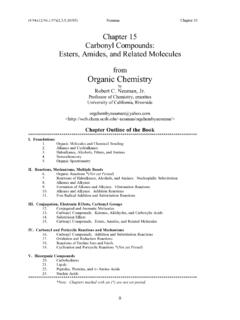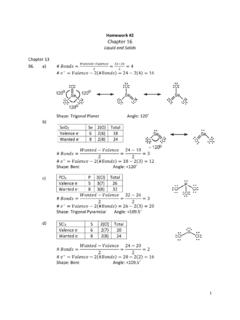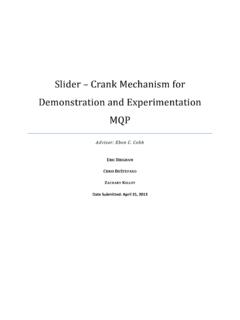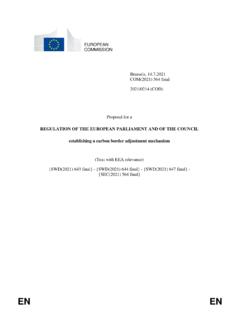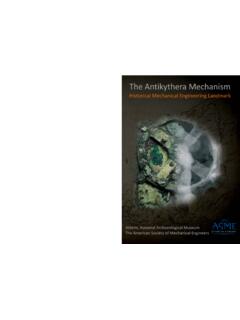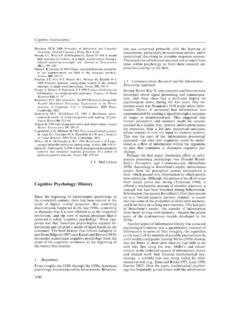Transcription of 7: Reactions of Haloalkanes, Alcohols, and Amines ...
1 (2/94)(1-3/96)(10,11/97)(9-12/00)(1,2,4- 6/01)NeumanChapter 77: Reactions of Haloalkanes, Alcohols, and Substitution Nucleophilic Substitution Reactions of Haloalkanes SN1 versus SN2 mechanisms Haloalkane Structure and Reactivity Stereochemistry of SN Reactions Reaction Rates of SN Reactions Other Nucleophiles Leaving Groups Nucleophilicity and Reaction Solvent Carbon Nucleophiles Nucleophilic HydrogenPreviewThis chapter describes nucleophilic substitution Reactions of Haloalkanes, alcohols, Amines , and compounds related to them. These are ionic Reactions inwhich one group on the molecule (a leaving group) is replaced by another group (anucleophile). The transformation of haloalkanes (R-X) into alcohols (R-OH) wherean OH group replaces the halogen (X) is an example of nucleophilic nucleophilic substitution Reactions take place by either the SN1 or the SN2mechanism.
2 The SN1 mechanism has an intermediate carbocation with a positivecharge on a carbon atom. Carbocation intermediates are planar and stabilized byalkyl groups. The SN2 mechanism has no intermediates and occurs in a single can distinguish SN1 and SN2 mechanisms by their stereochemistry andreaction groups and nucleophiles are often the same for both mechanisms , and thestructure of the reactant with the leaving group (the substrate) usually determinesthe reaction mechanism. The relative reactivities of nucleophiles (nucleophilicity)and leaving groups (leaving group ability) depend on their structures, their ioniccharge, and the (2/94)(1-3/96)(10,11/97)(9-12/00)(1,2,4- 6/01)NeumanChapter 7We illustrate these nucleophilic substitution mechanisms in this chapter using avariety of chemical Reactions . Besides recognizing these Reactions as nucleophilicsubstitutions you also need to learn them as individual Reactions that performspecific chemical transformations such as the conversion of a haloalkane (R-X) intoan alcohol (R-OH).
3 Nucleophilic Substitution Reactions of HaloalkanesNucleophilic substitution Reactions are ionic Reactions that break and makechemical bonds by transfers of pairs of electrons. We illustrate this using a generalrepresentation of a nucleophilic substitution reaction in which a halogen (X) isreplaced by a new group (N).R3C:X + -:N R3C:N + -:XThe color coding shows that the electron pair in the original C:X bond remains withthe halogen (X) as that bond breaks, while the electron pair on -:N becomes the newC:N chemical Substitution mechanisms ( )The two major mechanisms for nucleophilic substitution are called SN1 and SN2. Wedescribe them here using haloalkanes (R3C-X) as the SN1 Mechanism. The SN1 mechanism has two steps and an intermediatecarbocation R3C+.R3C:X R3C+ -:X*(1)R3C+ -:N R3C:N*(2)In the first step, the C-X bond in R3C-X breaks to give a negatively charged halideion (-:X) and positively charged carbocation (R3C+).
4 The name carbocation signifiesthat it is a carbon cation. Carbocations are also called carbonium ions. In thisionization reaction (a reaction that forms ions), the electron pair in the C-X bondremains with the halogen (X) as the C-X bond intermediate carbocation reacts in the second step with an unshared electronpair on the species -:N to form the new C:N bond. We use the letter N to signify that-:N is a nucleophile. A nucleophile is a chemical species with an unshared pair ofelectrons that reacts with electron deficient centers such as the C+ atom in R3C+.Nucleophile is derived from a combination of the chemical word nucleus and theGreek word philos which means "loving". A nucleophile wants ("loves") to use one ofits unshared electron pairs to bond to a positively polarized (2/94)(1-3/96)(10,11/97)(9-12/00)(1,2,4- 6/01)NeumanChapter 7 Nucleophiles always have an unshared electron pair that forms the new chemicalbond, but they are not always negatively charged.
5 When the nucleophile (:N) in anSN1 reaction is electrically neutral (uncharged), it reacts with the intermediatecarbocation to give a positively charged :X R3C+ -:X*(3)R3C+ :N R3C:N+*(4)Arrows Show How the Electrons Move. We illustrate the movement of the C:Xelectron pair in Reactions (1) and (3) above using curved arrows.[Note to Web Reader: Curved arrows and other "drawing" features need to be addedto some equations in this text file. These equations are noted with an asterix next tothe equation number [ see *(3) and *4) above ]. The equations containing thesefeatures are included as .gif files in the Figures folder!The tail of the arrow begins at the electron pair in the C:X bond and the head of thearrow points to X to show that the electron pair remains with X as the bond Reactions (2) and (4) we use arrows to show that the electron pair on -:N or :Nbinds to the C+ center of R3C+ to form the new C:N Meaning of SN1.]
6 SN1 stands for Substitution (S) Nucleophilic (N)Unimolecular (1) and organic chemists commonly refer to this mechanism as"unimolecular nucleophilic substitution". The term substitution indicates that onegroup (N) has taken the place of (substituted) another group (X). The termnucleophilic signifies that the new group N participates in the reaction as anucleophile. The term unimolecular tells us that there is only one reactant molecule(R3C-X) in the first reaction where the C-X bond breaks. We clarify the meaning ofthe term unimolecular later in the chapter, and in the next section where we describethe other major mechanism for nucleophilic SN2 Mechanism. In contrast with the two-step SN1 mechanism, the SN2mechanism has just one step and no :X -:N R3C:N -:X(5)The nucleophile -:N interacts directly with the haloalkane R3C:X by bonding to theC-X carbon while X is still bonded to (2/94)(1-3/96)(10,11/97)(9-12/00)(1,2,4- 6/01)NeumanChapter 7N:- C:X N +.
7 -X N:C-:X *(5a)There is no carbocation intermediate such as the one we saw in the SN1 middle structure with dotted bonds that we show above is not an will learn that it is a high energy unstable molecular configuration that thereactants must attain as they change from the haloalkane (R3C-X) to the product(R3C-N). SN2 signifies that the reaction is bimolecular nucleophilic substitution(SN). The number 2 in SN2 indicates that the C-X bond breaks in a reaction that isbimolecular since it includes both the haloalkane (R3C-X) and the nucleophile (N:- )as Caution. You must be careful to distinguish between the two possible meanings ofequation (5). You may see it used to illustrate the overall chemical transformation of R3 CXto R3CN that occurs in any nucleophilic substitution reaction whether the mechanism is SN1or SN2. However it may be the reaction that we write to specifically illustrate the SN2mechanism.
8 You must interpret the meaning of that reaction in the context that it is nucleophiles in SN2 Reactions are electrically neutral (:N), the product ispositively charged (R3C-N+) and we can represent the charge distribution duringthis SN2 reaction as we illustrate : C:X N +..C +.. -X +N:C-:X*(5b)SN1 and SN2 Reactions are Ionic. The pictorial description of the SN1 andSN2 mechanisms above show that nucleophilic substitution Reactions are ionic. Wehave seen that they may include ions such as negatively charged nucleophiles (N:-),positively charged substitution products (R3C-N+), and negatively charged halideions (X:-). The SN1 reaction has a positively charged intermediate carbocation(R3C+), while a partial positive charge develops on the C that is the site of bondmaking and bond breaking in the SN2 reaction. In all cases, the new C:N bondcomes from the pair of electrons on the nucleophile (N: or N:-), and the pair ofelectrons in the original C:X bond ends up on the halide ion leaving group (X:-).
9 4(2/94)(1-3/96)(10,11/97)(9-12/00)(1,2,4 -6/01)NeumanChapter 7 These ionic nucleophilic substitution Reactions of R3C-X are facilitated by the polarcharacter of their C-X bonds (Chapter 3). Halogen atoms (X) are moreelectronegative than the C to which they are bonded so the C-X bond has a positivelypolarized C and a negatively polarized X.[ ]The ionic character of these Reactions requires reaction solvents that can stabilizeions and polar species. We will learn more about these solvents later in the of Haloalkanes to Alcohols ( )We illustrate the SN1 and SN2 mechanisms using examples of Reactions wherebromoalkanes (R3C-Br) give alcohols (R3C-OH).t-Butyl Alcohol ((CH3)3C-OH) from t-Butyl Bromide ((CH3)3C-Br) (SN1). Ifwe reflux (heat to a boil) a mixture of 2-bromo-2-methylpropane (t-butyl bromide)and water (H2O), the reaction product 2-methylpropanol (t-butyl alcohol) forms as weshow here.
10 (CH3)3C-Br + H2O (CH3)3C-OH + HBr(6)(Since t-butyl bromide is relatively insoluble in water, we can facilitate the reactionby adding a solvent such as acetone that is miscible with water and helps dissolvethe haloalkane).Acetone. Acetone is a common organic solvent with the structure shown here. CH3-C-CH3 OIt is a member of a class of organic compounds called ketones that have the general structureR2C=O. While acetone is polar and dissolves a number of polar reactants used innucleophilic substitution Reactions , it is not nucleophilic. For this reason it is frequentlyused as a solvent in SN2 Reactions and sometimes in SN1 Reactions . We describe acetone ingreater detail when we formally introduce ketones in Chapter overall transformation of t-butyl bromide to t-butyl alcohol takes place by anSN1 mechanism with an intermediate t-butyl carbocation [see next page].

